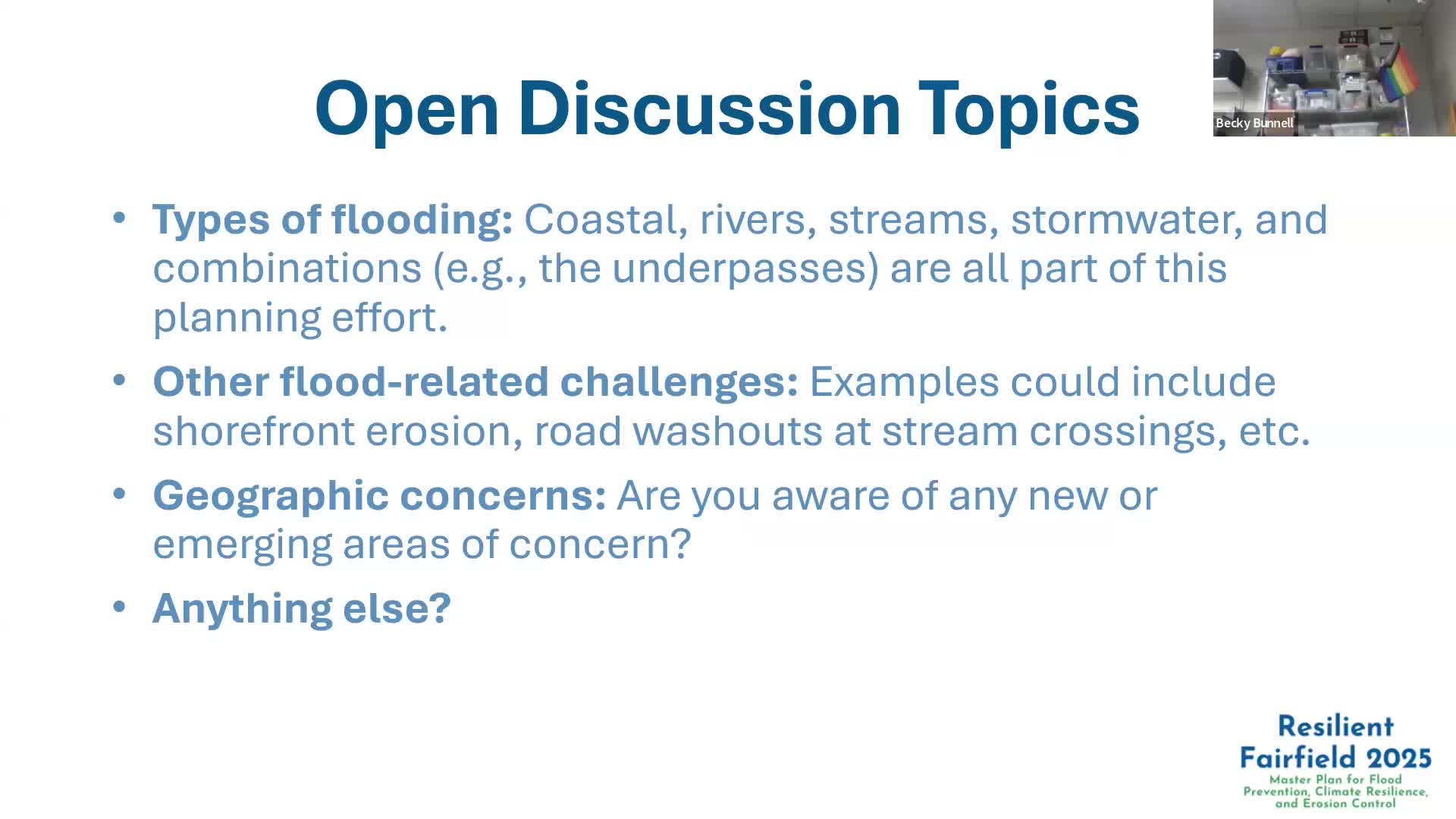Residents press Fairfield to dredge and build detention basins along Rooster River; town outlines active survey and RFP
March 02, 2025 | Fairfield, Fairfield, Connecticut
This article was created by AI summarizing key points discussed. AI makes mistakes, so for full details and context, please refer to the video of the full meeting. Please report any errors so we can fix them. Report an error »

Residents along the Rooster River watershed told town staff and consultants they consistently see storm drains overflow and water channeling into basements, and urged Fairfield to prioritize dredging and detention projects.
At the meeting one resident described the Rooster River as an “open storm drain” and said overflow from Bridgeport and Fairfield contributed to local flooding. The resident urged the town to dredge the riverbed to increase conveyance. Town staff said Bill Hurley had put a request on file for a survey and that a reconnaissance looking at riverbed elevation from Route 59 to Route 1 could show “a foot or two of dredging opportunity.” The town said that an RFP for the survey and initial excavation work would be issued within about four weeks.
Officials also described multiple detention basin projects that are moving forward now that the Army Corps of Engineers has completed its review and is expected to issue project authorization. Tunstall’s Hill and two sections at Fairchild/Wheeler (including a golf course site shared with Bridgeport) are named as near‑term detention projects; Owen Fish is in earlier design because shallow groundwater requires more study.
Town staff acknowledged practical limits: easements and environmental approvals will be required for channel work, and some dredging needs access from adjoining properties or Bridgeport’s side of the river. “There will be complications around easements,” a staff member said, asking residents to help obtain neighborhood consent where private land is implicated.
Why this matters: residents reported repeated, costly basement losses and urged quicker action. Officials said dredging and removal of obstructions can increase conveyance but are not a cure‑all: “None of these are 100% solutions,” a staff member said; dredging, detention basins and removal of debris can reduce but not eliminate flood peaks.
Implementation notes: the town said some funding already exists to proceed with limited dredging and clearing in the Route 59–Route 1 reach. The Army Corps’ permitting bottleneck that slowed detention basin projects has largely cleared; the town said it reduced environmental study fees by roughly 80% for one project to advance design and construction readiness. Officials encouraged residents to submit videos and site descriptions to help target survey work.
Residents offered practical steps including clearing debris, adding swirl chambers at catch basins, and volunteer neighborhood teams to assist with temporary deployment of barriers when storms are forecast. Town staff said they will log flood reports and incorporate them into the consultant mapping and prioritization work.
At the meeting one resident described the Rooster River as an “open storm drain” and said overflow from Bridgeport and Fairfield contributed to local flooding. The resident urged the town to dredge the riverbed to increase conveyance. Town staff said Bill Hurley had put a request on file for a survey and that a reconnaissance looking at riverbed elevation from Route 59 to Route 1 could show “a foot or two of dredging opportunity.” The town said that an RFP for the survey and initial excavation work would be issued within about four weeks.
Officials also described multiple detention basin projects that are moving forward now that the Army Corps of Engineers has completed its review and is expected to issue project authorization. Tunstall’s Hill and two sections at Fairchild/Wheeler (including a golf course site shared with Bridgeport) are named as near‑term detention projects; Owen Fish is in earlier design because shallow groundwater requires more study.
Town staff acknowledged practical limits: easements and environmental approvals will be required for channel work, and some dredging needs access from adjoining properties or Bridgeport’s side of the river. “There will be complications around easements,” a staff member said, asking residents to help obtain neighborhood consent where private land is implicated.
Why this matters: residents reported repeated, costly basement losses and urged quicker action. Officials said dredging and removal of obstructions can increase conveyance but are not a cure‑all: “None of these are 100% solutions,” a staff member said; dredging, detention basins and removal of debris can reduce but not eliminate flood peaks.
Implementation notes: the town said some funding already exists to proceed with limited dredging and clearing in the Route 59–Route 1 reach. The Army Corps’ permitting bottleneck that slowed detention basin projects has largely cleared; the town said it reduced environmental study fees by roughly 80% for one project to advance design and construction readiness. Officials encouraged residents to submit videos and site descriptions to help target survey work.
Residents offered practical steps including clearing debris, adding swirl chambers at catch basins, and volunteer neighborhood teams to assist with temporary deployment of barriers when storms are forecast. Town staff said they will log flood reports and incorporate them into the consultant mapping and prioritization work.
View full meeting
This article is based on a recent meeting—watch the full video and explore the complete transcript for deeper insights into the discussion.
View full meeting
